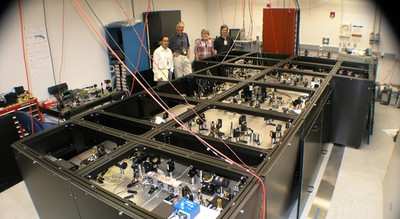And Finding Them May Have Gotten A Little Easier
 Many scientists speculate that our galaxy could be full of
places like Pandora from the movie "Avatar" -- Earth-like worlds in
solar systems besides our own. That doesn't mean such worlds have
been easy to find, however. Of the 400-plus planets discovered so
far, none could support life as we know it on Earth.
Many scientists speculate that our galaxy could be full of
places like Pandora from the movie "Avatar" -- Earth-like worlds in
solar systems besides our own. That doesn't mean such worlds have
been easy to find, however. Of the 400-plus planets discovered so
far, none could support life as we know it on Earth.
"The problem with finding Earth-like planets," said Stefan
Martin, an engineer at NASA's Jet Propulsion Laboratory, Pasadena,
CA, "is that their host stars can emit 10 million times more
infrared light than the planet itself. And because planets like
ours are small and orbit very close to their respective stars, it
makes Earths almost impossible to see."
Together with A.J. Booth (formerly at JPL and now at Sigma Space
Corp., Lanham, MD.), Martin may have developed a way to make this
almost impossible feat a reality.
Their instrument design, called a "nulling interferometer,"
observes planets in infrared light, where they are easier to
detect. It is designed to combine starlight captured by four
different telescopes, arranging the light waves from the star in
such a way that they cancel each other out. "We're able to make the
star look dimmer -- basically turning it off," Martin said.
Nulling interferometry is not a new idea, but what sets the
results from Martin and Booth apart is how effective it turned out
to be. "Our null depth is 10 to 100 times better than previously
achieved by other systems," Martin said. "This is the first time
someone has cross-combined four telescopes, set up in pairs, and
achieved such deep nulls. It's extreme starlight suppression."
That suppression could allow scientists to get a better look at
exoplanets than ever before. "We're able to make the planet flash
on and off so that we can detect it," Martin said. "And because
this system makes the light from the star appear 100 million times
fainter, we would be able to see the planet we're looking for quite
clearly."

JPL's Nulling Interferometer
Nulling interferometry isn't the only way scientists can find
other Earths. NASA's Kepler mission, currently in orbit, is looking
for Earth-like planets by watching the light of faraway stars dim
slightly as their planets pass in front of them. Another method of
observing exoplanets is coronagraphy, which uses a mask to block
the optical light of a star, making its surrounding planets more
easily visible. And the proposed SIM Lite mission would also be
able to find nearby planets by observing the gravity-induced
"wobbling" of their host stars.
However, Martin and Booth's nulling interferometer could
eventually give astronomers the ability to get up close and
personal with Earth-like worlds, analyzing their atmospheres for
signs of habitability or even possibly life. "We expect to
eventually be able to see hundreds of planets with this technique,"
Martin said.
The technology that they've developed could be used on a
follow-up space mission to SIM Lite and Kepler. Martin is now
planning to test the system in conditions that better mimic a
real-life mission. Once considered the stuff of science fiction, it
may not be long before Earth-like planets, or, in the case of
Pandora, Earth-like moons of giant planets, are found to exist
other places besides the silver screen.
 Aero-News: Quote of the Day (05.09.24)
Aero-News: Quote of the Day (05.09.24) ANN's Daily Aero-Term (05.09.24): Hold Procedure
ANN's Daily Aero-Term (05.09.24): Hold Procedure ANN's Daily Aero-Linx (05.09.24)
ANN's Daily Aero-Linx (05.09.24) Airborne 05.03.24: Advanced Powerplant Solutions, PRA Runway Woes, Drone Racing
Airborne 05.03.24: Advanced Powerplant Solutions, PRA Runway Woes, Drone Racing Airborne-NextGen 05.07.24: AI-Piloted F-16, AgEagle, 1st 2 WorldView Sats
Airborne-NextGen 05.07.24: AI-Piloted F-16, AgEagle, 1st 2 WorldView Sats




